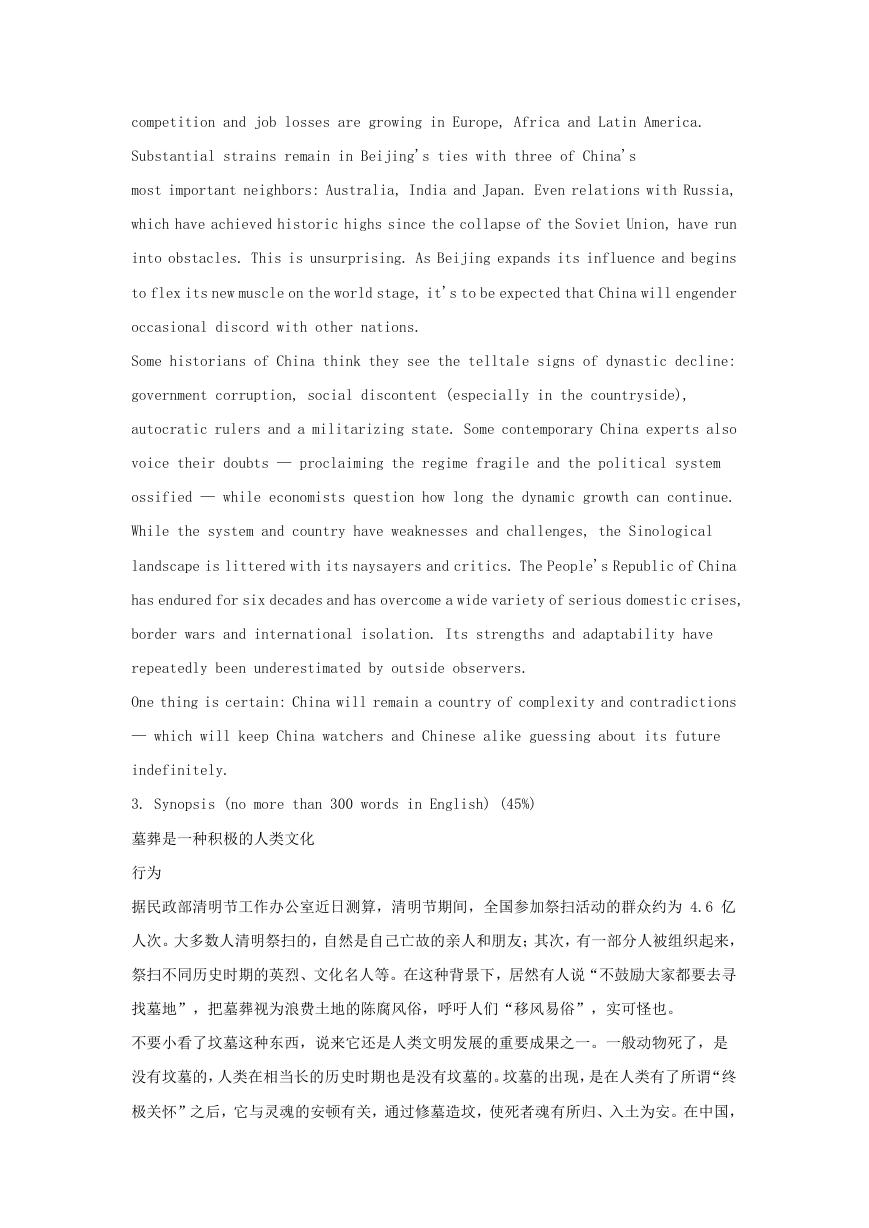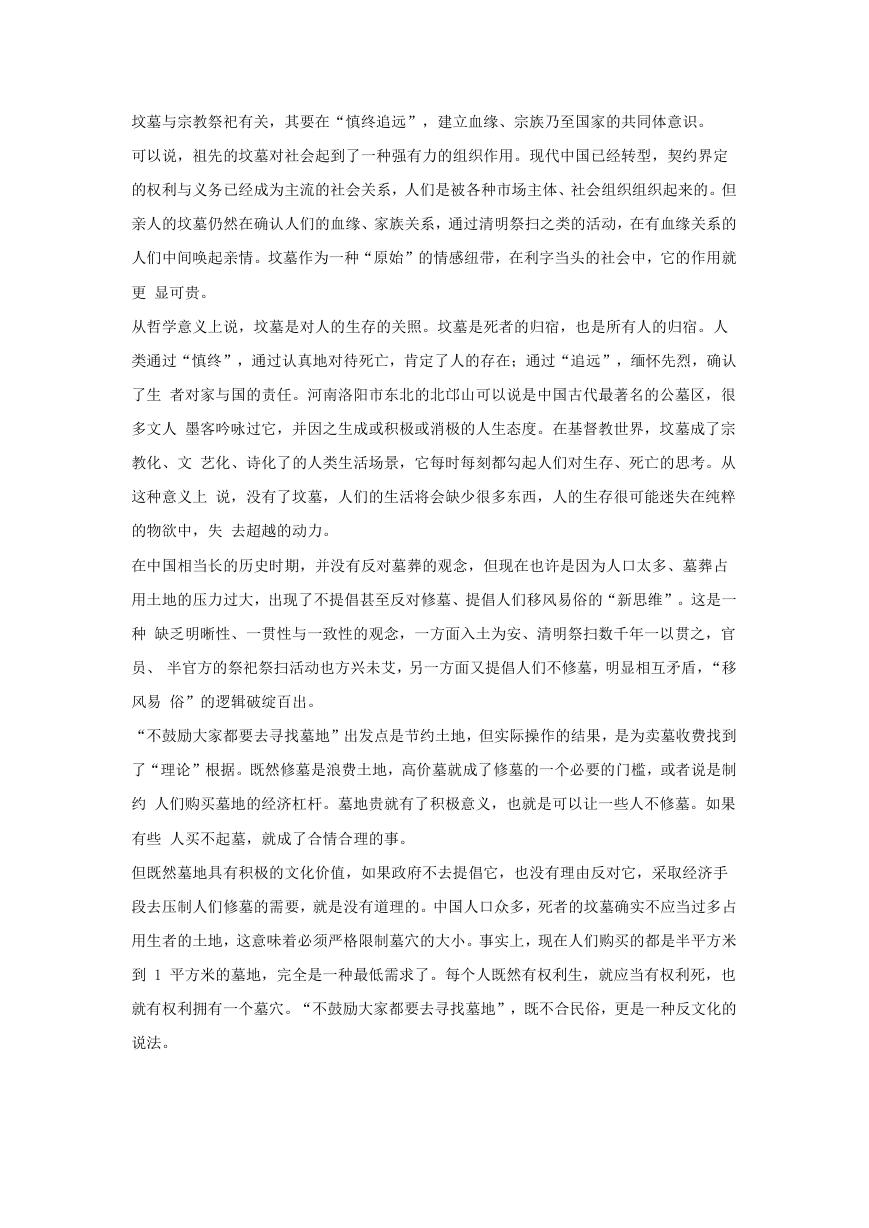2011 年上海外国语大学翻译硕士考研真题
1. 完型:15 空(15%)
Taking On the World
Any consideration of China's transformation since 1949 must recognize the dramatic
improvement in China's global posture. Sixty years ago the new People's Republic
was cut off from the world, having diplomatic recognition only from a relatively
small number of nations. It was excluded from the U.N. It soon became embroiled in
the Korean War and the Cold War, which brought further isolation. Despite some
marginal trade with Western Europe following the 1954 Geneva Conference on Indochina,
China was cut off from international trade, finance and aid. As a result, its economy
stagnated.
Six decades later, China has fully embraced globalization at home and has burst onto
the world's stage in a largely positive fashion. It now has both interests and a
presence in parts of the world completely new to China — such as Latin America and
the Middle East — and enjoys rising international prestige. Beijing has generally
managed its relations well with the major world powers: the U.S., Russia and the
E.U. It has transformed its regional diplomacy in Asia, reasserted a role in Africa
and become much more deeply engaged with international organizations and
across a range of global-governance issues. China used to eschew multilateralism,
distrusting it as some kind of (Western) conspiracy. While Beijing remains a
selective multilateralist globally — engaging on some issues and not others — the
broad trend has been positive and in the direction of deeper contributions to the
world community.
2. 翻译:英译汉 (40%)
Still, many countries worry about China's rise and global expansion, even though
it has, to date, been outwardly peaceful. Public opinion polls in Europe and the
U.S. regularly reflect a negative image of China, while concerns over economic
�
competition and job losses are growing in Europe, Africa and Latin America.
Substantial strains remain in Beijing's ties with three of China's
most important neighbors: Australia, India and Japan. Even relations with Russia,
which have achieved historic highs since the collapse of the Soviet Union, have run
into obstacles. This is unsurprising. As Beijing expands its influence and begins
to flex its new muscle on the world stage, it's to be expected that China will engender
occasional discord with other nations.
Some historians of China think they see the telltale signs of dynastic decline:
government corruption, social discontent (especially in the countryside),
autocratic rulers and a militarizing state. Some contemporary China experts also
voice their doubts — proclaiming the regime fragile and the political system
ossified — while economists question how long the dynamic growth can continue.
While the system and country have weaknesses and challenges, the Sinological
landscape is littered with its naysayers and critics. The People's Republic of China
has endured for six decades and has overcome a wide variety of serious domestic crises,
border wars and international isolation. Its strengths and adaptability have
repeatedly been underestimated by outside observers.
One thing is certain: China will remain a country of complexity and contradictions
— which will keep China watchers and Chinese alike guessing about its future
indefinitely.
3. Synopsis (no more than 300 words in English) (45%)
墓葬是一种积极的人类文化
行为
据民政部清明节工作办公室近日测算,清明节期间,全国参加祭扫活动的群众约为 4.6 亿
人次。大多数人清明祭扫的,自然是自己亡故的亲人和朋友;其次,有一部分人被组织起来,
祭扫不同历史时期的英烈、文化名人等。在这种背景下,居然有人说“不鼓励大家都要去寻
找墓地”,把墓葬视为浪费土地的陈腐风俗,呼吁人们“移风易俗”,实可怪也。
不要小看了坟墓这种东西,说来它还是人类文明发展的重要成果之一。一般动物死了,是
没有坟墓的,人类在相当长的历史时期也是没有坟墓的。坟墓的出现,是在人类有了所谓“终
极关怀”之后,它与灵魂的安顿有关,通过修墓造坟,使死者魂有所归、入土为安。在中国,
�
坟墓与宗教祭祀有关,其要在“慎终追远”,建立血缘、宗族乃至国家的共同体意识。
可以说,祖先的坟墓对社会起到了一种强有力的组织作用。现代中国已经转型,契约界定
的权利与义务已经成为主流的社会关系,人们是被各种市场主体、社会组织组织起来的。但
亲人的坟墓仍然在确认人们的血缘、家族关系,通过清明祭扫之类的活动,在有血缘关系的
人们中间唤起亲情。坟墓作为一种“原始”的情感纽带,在利字当头的社会中,它的作用就
更 显可贵。
从哲学意义上说,坟墓是对人的生存的关照。坟墓是死者的归宿,也是所有人的归宿。人
类通过“慎终”,通过认真地对待死亡,肯定了人的存在;通过“追远”,缅怀先烈,确认
了生 者对家与国的责任。河南洛阳市东北的北邙山可以说是中国古代最著名的公墓区,很
多文人 墨客吟咏过它,并因之生成或积极或消极的人生态度。在基督教世界,坟墓成了宗
教化、文 艺化、诗化了的人类生活场景,它每时每刻都勾起人们对生存、死亡的思考。从
这种意义上 说,没有了坟墓,人们的生活将会缺少很多东西,人的生存很可能迷失在纯粹
的物欲中,失 去超越的动力。
在中国相当长的历史时期,并没有反对墓葬的观念,但现在也许是因为人口太多、墓葬占
用土地的压力过大,出现了不提倡甚至反对修墓、提倡人们移风易俗的“新思维”。这是一
种 缺乏明晰性、一贯性与一致性的观念,一方面入土为安、清明祭扫数千年一以贯之,官
员、 半官方的祭祀祭扫活动也方兴未艾,另一方面又提倡人们不修墓,明显相互矛盾,“移
风易 俗”的逻辑破绽百出。
“不鼓励大家都要去寻找墓地”出发点是节约土地,但实际操作的结果,是为卖墓收费找到
了“理论”根据。既然修墓是浪费土地,高价墓就成了修墓的一个必要的门槛,或者说是制
约 人们购买墓地的经济杠杆。墓地贵就有了积极意义,也就是可以让一些人不修墓。如果
有些 人买不起墓,就成了合情合理的事。
但既然墓地具有积极的文化价值,如果政府不去提倡它,也没有理由反对它,采取经济手
段去压制人们修墓的需要,就是没有道理的。中国人口众多,死者的坟墓确实不应当过多占
用生者的土地,这意味着必须严格限制墓穴的大小。事实上,现在人们购买的都是半平方米
到 1 平方米的墓地,完全是一种最低需求了。每个人既然有权利生,就应当有权利死,也
就有权利拥有一个墓穴。“不鼓励大家都要去寻找墓地”,既不合民俗,更是一种反文化的
说法。
�






 2023年江西萍乡中考道德与法治真题及答案.doc
2023年江西萍乡中考道德与法治真题及答案.doc 2012年重庆南川中考生物真题及答案.doc
2012年重庆南川中考生物真题及答案.doc 2013年江西师范大学地理学综合及文艺理论基础考研真题.doc
2013年江西师范大学地理学综合及文艺理论基础考研真题.doc 2020年四川甘孜小升初语文真题及答案I卷.doc
2020年四川甘孜小升初语文真题及答案I卷.doc 2020年注册岩土工程师专业基础考试真题及答案.doc
2020年注册岩土工程师专业基础考试真题及答案.doc 2023-2024学年福建省厦门市九年级上学期数学月考试题及答案.doc
2023-2024学年福建省厦门市九年级上学期数学月考试题及答案.doc 2021-2022学年辽宁省沈阳市大东区九年级上学期语文期末试题及答案.doc
2021-2022学年辽宁省沈阳市大东区九年级上学期语文期末试题及答案.doc 2022-2023学年北京东城区初三第一学期物理期末试卷及答案.doc
2022-2023学年北京东城区初三第一学期物理期末试卷及答案.doc 2018上半年江西教师资格初中地理学科知识与教学能力真题及答案.doc
2018上半年江西教师资格初中地理学科知识与教学能力真题及答案.doc 2012年河北国家公务员申论考试真题及答案-省级.doc
2012年河北国家公务员申论考试真题及答案-省级.doc 2020-2021学年江苏省扬州市江都区邵樊片九年级上学期数学第一次质量检测试题及答案.doc
2020-2021学年江苏省扬州市江都区邵樊片九年级上学期数学第一次质量检测试题及答案.doc 2022下半年黑龙江教师资格证中学综合素质真题及答案.doc
2022下半年黑龙江教师资格证中学综合素质真题及答案.doc